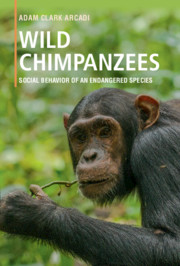Book contents
- Wild Chimpanzees
- Wild Chimpanzees
- Copyright page
- Dedication
- Contents
- Preface
- 1 Primates, Apes, and the Study of Chimpanzee Social Behavior
- 2 Seven Long-Term Field Studies
- 3 Chimpanzee Fission–Fusion Social Organization and Its Conservation Implications
- 4 Sex Differences in Ranging and Association Patterns
- 5 Female Social Relationships
- 6 Male Social Relationships
- 7 Sexual Behavior: Conflicting Strategies of Males and Females
- 8 Coalitionary Lethal Aggression between and within Communities
- 9 Hunting, Eating, and Sharing Meat
- 10 Communication: The Form and Content of Signals
- 11 Community Differences in Grooming Postures and Tool Use: Innovation, Social Learning, and the Question of “Culture”
- Epilogue
- Appendix: Field Methods for Studying Wild Chimpanzees
- End Notes
- References
- Index
- Plate Section (PDF Only)
Appendix: Field Methods for Studying Wild Chimpanzees
Published online by Cambridge University Press: 01 June 2018
- Wild Chimpanzees
- Wild Chimpanzees
- Copyright page
- Dedication
- Contents
- Preface
- 1 Primates, Apes, and the Study of Chimpanzee Social Behavior
- 2 Seven Long-Term Field Studies
- 3 Chimpanzee Fission–Fusion Social Organization and Its Conservation Implications
- 4 Sex Differences in Ranging and Association Patterns
- 5 Female Social Relationships
- 6 Male Social Relationships
- 7 Sexual Behavior: Conflicting Strategies of Males and Females
- 8 Coalitionary Lethal Aggression between and within Communities
- 9 Hunting, Eating, and Sharing Meat
- 10 Communication: The Form and Content of Signals
- 11 Community Differences in Grooming Postures and Tool Use: Innovation, Social Learning, and the Question of “Culture”
- Epilogue
- Appendix: Field Methods for Studying Wild Chimpanzees
- End Notes
- References
- Index
- Plate Section (PDF Only)
Summary
HABITUATING, FINDING, AND FOLLOWING CHIMPANZEES
Wild chimpanzees flee from people if they are unaccustomed to seeing them. If they are tracked persistently and unobtrusively, however, they will gradually become used to the presence of human observers. This process of “habituation,” in which the animals increasingly ignore unobtrusive onlookers, progresses through several stages. In the early phases, individuals feeding in the safety of the forest canopy will tolerate being watched from below but will quickly run once they descend to the ground to travel. Some months later, they may tolerate being quietly followed as they travel on the ground to a new feeding area, provided the observers remain twenty or thirty meters away. Some individuals may even rest and socialize on the ground in view of onlookers, as long as the humans keep their distance. As habituation continues, some animals begin to come within five to ten meters, perhaps passing by a researcher to approach a grooming partner, but will still move away if the researcher tries to approach them to that distance. Finally, after years of being tracked, most chimpanzees appear to ignore observers completely as they pursue their daily activities. At this stage, now fully habituated, they may literally brush past a researcher as they make their way along a path.
The most desirable data on wild chimpanzees are collected from fully habituated populations that are otherwise largely shielded from contact with humans. There are several reasons for this. First, researchers do not want their presence to affect the behavior of the animals they are watching. This appears to be achieved after complete habituation, when study animals show no visible fear of humans and engage in routine social and subsistence behaviors without looking at or otherwise directing behavior toward observers. Although chimpanzees everywhere have probably been influenced to some degree by human contact (people enter forests regularly for a variety of reasons – to collect firewood, edible plants, and medicinal plants; to hunt game, including chimpanzees at some locations; to extract lumber; to find refuge during warfare; and so on), habituated animals in protected areas nevertheless appear to offer an accurate picture of chimpanzee life unaltered by human influence.
- Type
- Chapter
- Information
- Wild ChimpanzeesSocial Behavior of an Endangered Species, pp. 147 - 156Publisher: Cambridge University PressPrint publication year: 2018



